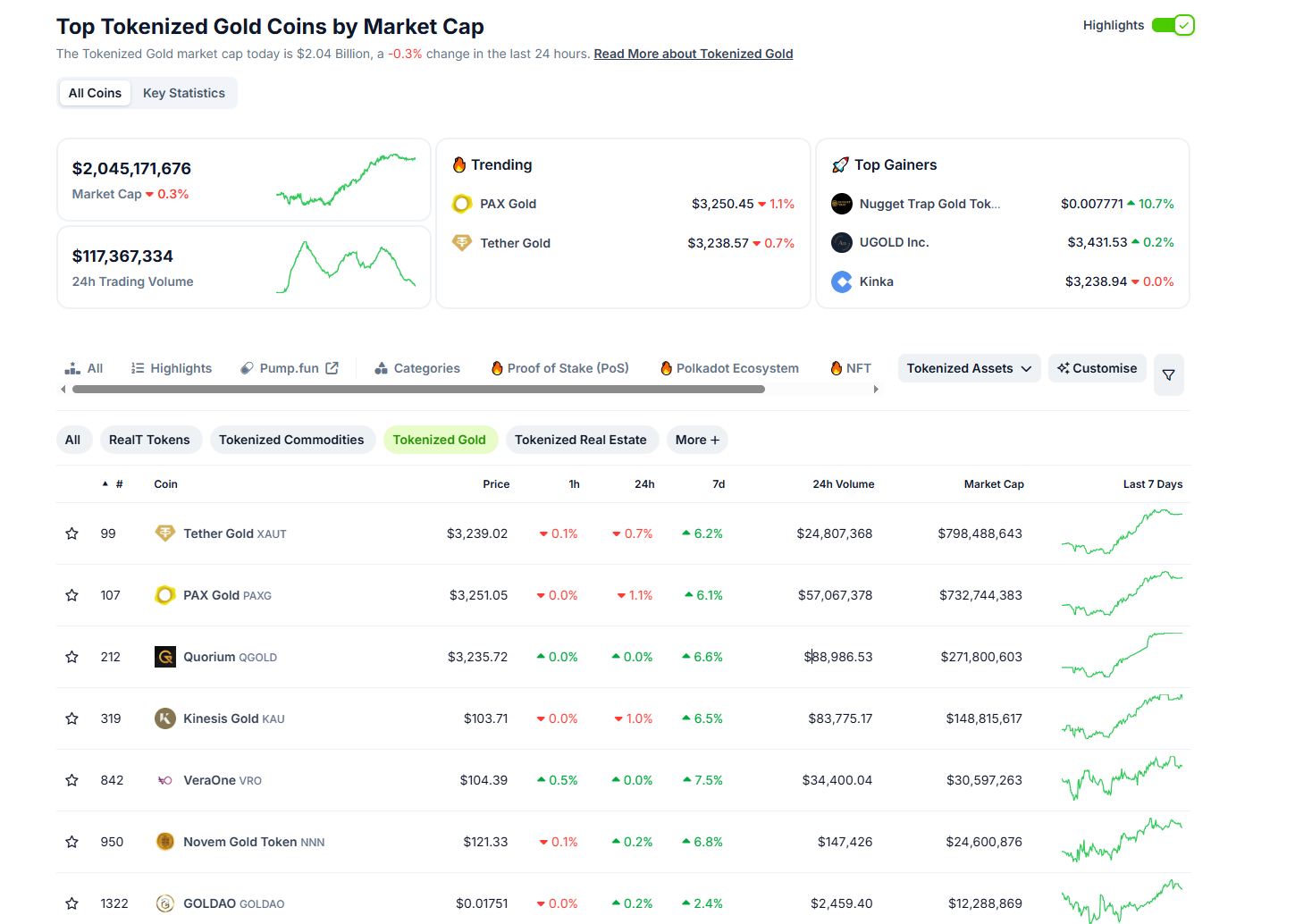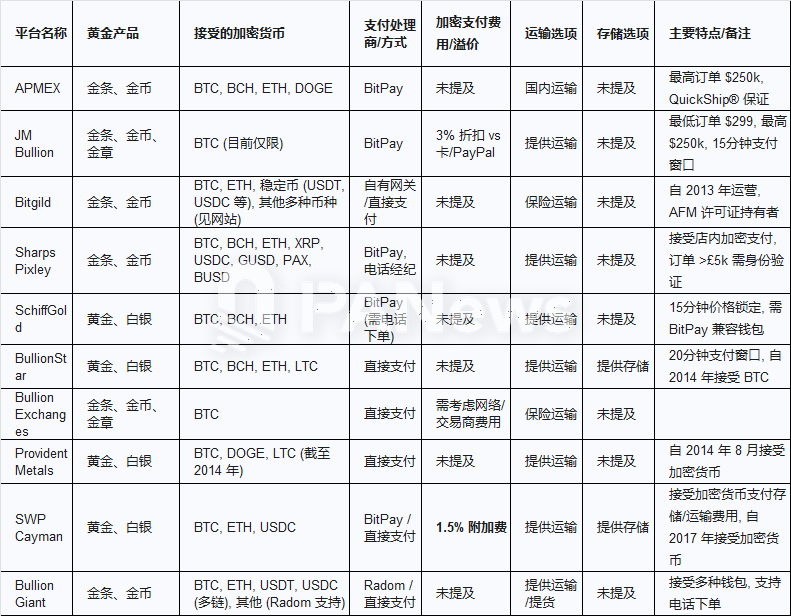Gold has set new highs in a row. How to invest in gold targets in the crypto market?

Reprinted from panewslab
04/15/2025·11DAuthor: Frank, PANews
When Bitcoin encounters a "value winter", real-world gold is recasting the value iron curtain on the blockchain.
Recently, the volatility of the crypto market has become increasingly uncertain with the changes in the international financial market, and the price trends of Bitcoin, Ethereum, SOL, and other mainstream crypto assets have also fallen into a downturn. The market's enthusiasm for crypto trading seems to be moving from optimism to a bear-looking state. In sharp contrast, international gold prices have been rising all the way through $3,240 per ounce, constantly setting new historical highs, and using prices to verify that gold is the attribute of safe-haven assets.
In the crypto market, the market value of assets linked to gold has also risen. On April 11, the market value of tokenized gold assets exceeded US$2 billion. From a risk hedging perspective, gold-related crypto assets seem to be becoming a new and high-quality option. PANews takes stock of current mainstream gold-related trading exposures in the crypto market.
The exposure to gold-related transactions in the crypto market is currently divided into tokenized gold, such as TetherGold (XAUT) or PAXGold (PAXG), which are essentially digital certificates of physical gold ownership. and derivative transactions that use these tokenized gold to trade with stablecoins. As provided by the exchange, XAUT or PAXG spot trading pair or contract trading pair. In addition, some online precious metal traders support cryptocurrencies as payment methods when trading physical gold. These gold participation methods have different deviations in terms of risk preference and fund flexibility.
XAUT and PAXG: Leading Projects for Tokenized Gold
TetherGold (XAUT) and PAXGold (PAXG) are the two largest market-capable varieties on the tokenized gold market. XAUT is issued by USDT publisher Tether, 1XAUT corresponds to ownership of 1 troy ounce of gold on a "good delivery" bar recognized by a specific LBMA (London Gold and Silver Market Association). Gold is assigned to the designated distribution, and holders can check the unique serial number, purity and weight of the gold bars associated with their address through the official website. Tether claims that its reserves support 100% of the issuance of tokens, and XAUT is backed by the gold part in the reserves. As of April 12, XAUT's total support volume was 7,667.7 kilograms of gold, distributed on 644 gold bars, and the market value of XAUT tokens was approximately US$797 million.
 PAXG is issued by
Paxos TrustCompany, a trust company and custodian regulated by the New York
State Department of Financial Services (NYDFS). PAXG is also the ownership of
each token corresponding to 1 troy ounce of London Good Delivery Bar. The
monthly issuance of PAXG will be released by a third-party auditing company.
The report as of February 28 shows that the company holds 209,160 ounces of
gold (approximately 5,929 kg).
PAXG is issued by
Paxos TrustCompany, a trust company and custodian regulated by the New York
State Department of Financial Services (NYDFS). PAXG is also the ownership of
each token corresponding to 1 troy ounce of London Good Delivery Bar. The
monthly issuance of PAXG will be released by a third-party auditing company.
The report as of February 28 shows that the company holds 209,160 ounces of
gold (approximately 5,929 kg).
Compared with traditional gold ETFs or futures, XAUT and PAXG have no custodial fees and have a smaller minimum purchase volume.
PAXG's fee structure is different from XAUT. Creating or destroying PAXG directly through the Paxos platform will incur ladder fees based on transaction volume, and on-chain transfers will charge a 0.02% Paxos fee. By comparison, XAUT claims no hosting fee but charges a 0.25% fee when it comes to direct purchase/redemption. This means that for small users, trading PAXG on secondary exchanges may be more cost-effective than operating directly through the Paxos platform, avoiding creation or destruction fees. Frequent on-chain transfers will incur additional costs.
Kinesis and gold mine model of self-operated mint Quorium
In addition, tokenized gold products with a market value of more than 100 million include Quorium (QGLOD) and Kinesis Gold (KAU). QGLOD's business model is relatively special, and the gold it holds is essentially gold reserves rather than spot gold. In addition, although the project party claims to have regular reports on gold reserves, PANews found that these web pages could no longer be opened. Therefore, it is impossible to understand the reserve status of QGLOD. The information is vague, contradictory, and there is a lack of key details of independent verification by third parties. In particular, the concept of "unexploited reserves" and how it provides stable support for liquidity tokens and how to conduct audits and valuations are all open questions, which brings great uncertainty and risks to investors.
In addition, QGOLD's market data showed some warning signals. Its market value (about US$270 million) is relatively high, but its daily trading volume is abnormally low (about US$100,000), and it is concentrated in a few low-profile exchanges. This serious mismatch between market value and trading volume and exchange liquidity, coupled with insufficient transparency, makes the security of QGLOD seem to be unconvincing.
The pricing method of KinesisGold is different from that of PAXG or XAUT, and each token represents 1 gram of gold. Its core differentiation lies in its unique revenue sharing model. Unlike tokens like PAXG and XAUT that track only gold prices, KAU returns some of the platform's transaction fees to holders in the form of gold (KAU). However, this benefit is not fixed or risk-free, and its size depends directly on the overall transaction volume and fee income of the Kinesis platform. In addition, Kinesis has also launched a corresponding virtual card, where users can directly use KAU for daily consumption, which is also a difference between KAU. In terms of transparency, Kinesis chose to audit every six months and supports delivery of physical items every 100 grams. According to Kinesis official information, Kinesis operates a 5,600-square-meter mint and refinery KinesisMint, which produces high-quality gold and silver ingots.
In terms of market circulation, XAUT and PAXG are still the two tokenized gold with the best liquidity, and can be traded on many mainstream centralized exchanges and DEXs. KAU can trade on its own Kinesis Exchange platform and centralized exchanges such as BitMart and Emirex, with a slight lack of liquidity.

There are many exposures for spot delivery, and gold tokens are difficult
to break the DeFi dimension wall
In addition to tokenized gold, many traditional precious metal dealers also support payments in cryptocurrencies. This gold exposure is mainly suitable for spot trading, and cryptocurrencies are only used as payment methods, not fundamental changes in business models. In addition, this type of trading method usually requires a higher threshold for one-time investment, and many products traded on the platform are products such as gold coins or gold seals. In addition to the value of gold itself, users may also need product identification and premium identification capabilities.

In addition to trading tokenized gold such as PAXG or XAUT, there are some centralized exchanges that offer different gold trading categories. If Bybit provides a gold contract of difference (CFD), CFD allows traders to speculate on price changes in an asset (such as gold) without actually owning the asset. This kind of transaction is similar to index contract trading in the financial market, where users only track the gold price trend and place contract orders, but ultimately cannot deliver gold spot. Among the mainstream centralized exchanges, only Bybit seems to provide similar products, but many traditional XAU/USD CFD platforms now accept cryptocurrency deposits, such as FP Markets, Fusion Markets, easyMarkets, etc. This trading method is more suitable for professional traders who are familiar with trading such as gold forex rather than cryptocurrency investors.
In addition, although gold tokens have the attributes of RWA, the adoption of such products on mainstream DeFi lending platforms seems to be limited. In addition to PAXG's staking income through Morpho, leading agreements such as Aave and Compound have not accepted gold tokens as native collateral. This may stem from several factors: First, there may be challenges in reliable and decentralized gold price oracles, which are crucial to the clearing mechanism; second, potential regulatory uncertainty; third, compared with ETH or mainstream stablecoins, the market demand for gold tokens as collateral may be relatively low.
In general, among the current exposure of crypto markets to participate in gold assets, the most mainstream way may still be to hold mainstream, highly liquid gold tokens such as PAXG or XAUT. In addition, although there are many similar tokenized gold products, due to the issuer and transparency identification issues, users may also consider the security issues involved while choosing these assets. While purchasing physical gold directly through traditional precious metal dealers who accept payments from cryptocurrencies provides the most direct ownership, it is also accompanied by higher thresholds and potential product premium issues. In the DeFi field, the way of participation of gold assets is still limited, which may be a problem for the deep integration of most RWA assets with on-chain finance.
And Bitcoin holders in the downward cycle are beginning to turn their attention to real gold, which is not only a footnote to the maturation of the crypto market, but also a value counterattack launched by digital gold to the real world.
